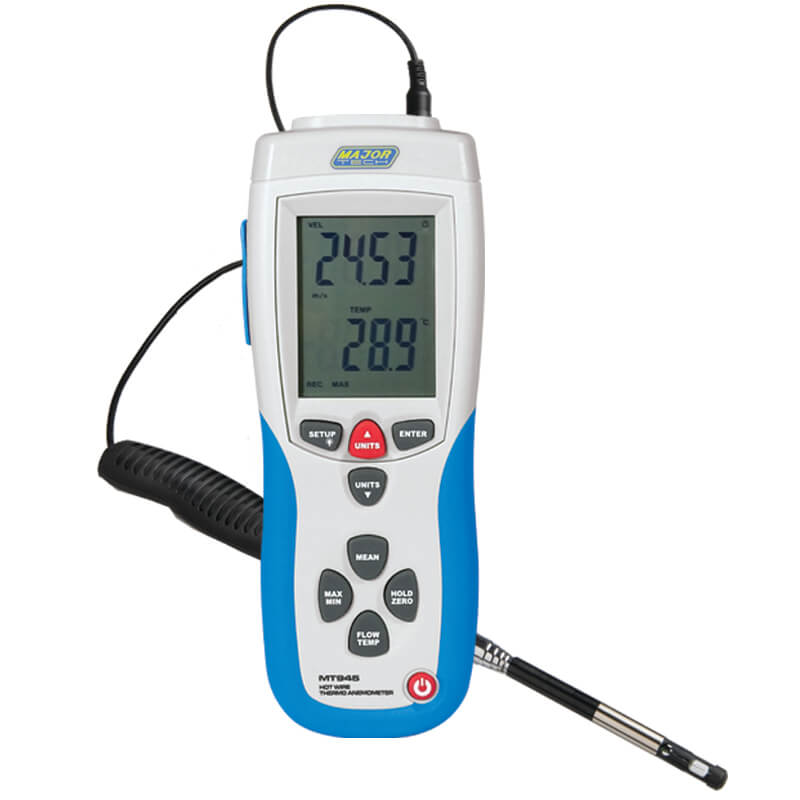Picking the Right Anemometer: A Comprehensive Acquiring Guide
Picking the Right Anemometer: A Comprehensive Acquiring Guide
Blog Article
All You Need to Understand About Anemometers: Exactly How They Work, Why They Issue, and Where to Make use of Them
Anemometers, however typically forgotten in the realm of scientific tools, play a crucial function in different fields, offering important understandings right into wind rate and airflow patterns. As we delve into the ins and outs of anemometer innovation, we will certainly uncover the inner workings of these devices, their relevance, and the vital factors to consider when selecting the right anemometer for certain applications.

Anemometer Fundamentals
A necessary instrument utilized to measure wind speed and instructions, the anemometer plays a vital duty in weather forecasting and different industries. An anemometer generally includes 3 or 4 cups that rotate in the wind, a vane that aims right into the wind, and sensors to track the rotations or movements. By determining the rotations or activities over a certain period, the anemometer can establish wind speed. The vane assists determine wind direction by pointing into the wind, supplying beneficial information for climate forecasting, aviation, maritime operations, ecological surveillance, and wind power applications.
There are different types of anemometers offered, including mug anemometers, vane anemometers, hot-wire anemometers, and sonic anemometers, each with its special attributes and applications. Mug anemometers are typically utilized for fundamental wind rate dimensions, while vane anemometers are liked for directional dimensions.
Principles of Anemometer Operation
Structure on the foundational understanding of anemometer basics, the principles of anemometer operation clarify the technicians behind wind rate and direction dimensions. Cup anemometers, for circumstances, have 3 or more cups that capture the wind, causing them to rotate quicker as the wind speed increases. Hot-wire anemometers rely on a warmed cable that cools down as wind passes over it, with the price of cooling down establishing the wind speed.
Significance of Anemometers
The significance of anemometers in weather forecasting and various industries can not be overemphasized. Anemometers play a vital function in measuring wind rate and direction, providing crucial data for climate forecasting, environment research studies, ecological tracking, and aviation operations. Meteorologists count on anemometers to collect accurate wind data, helping them recognize weather condition patterns, predict storms, click for info and concern timely warnings to the general public. In sectors such as building and construction, agriculture, eco-friendly power, and maritime procedures, anemometers are utilized to maximize procedures, make sure safety and security, and raise performance. Wind ranch operators make use of anemometers to link examine wind problems and take full advantage of electrical energy production from wind turbines. In the maritime market, anemometers help ship navigation by giving real-time wind info to captains, helping them make educated decisions to guarantee risk-free voyages. On the whole, anemometers are vital devices that contribute substantially to safety and security, efficiency, and informed decision-making in weather forecasting and a wide variety of markets.
Applications Across Numerous Industries
In the renewable power market, anemometers play a crucial function in examining wind problems for wind ranch positionings, ensuring optimal energy production. Industries like building and construction and mining utilize anemometers to monitor wind speeds, essential for security methods, specifically when functioning at elevations or in open-pit mines where strong winds can present dangers. In farming, anemometers help farmers in managing plant splashing by giving real-time information on wind rate to prevent drift.

Choosing the Right Anemometer for Your Demands
Choosing the ideal anemometer tailored to your certain demands is essential for acquiring precise wind rate and instructions dimensions. When choosing an anemometer, consider elements such as the designated application, needed dimension array, ecological problems, and desired features. For general functions, a mug anemometer appropriates for gauging wind speed, while a vane anemometer offers wind instructions data. Hot-wire anemometers are excellent for reduced airspeed measurements, and ultrasonic anemometers offer high precision and durability.

Final Thought
Finally, anemometers play a crucial duty in determining wind speed and direction across different industries. Understanding the principles of anemometer procedure is essential for choosing the best tool for details demands. From weather forecasting to air travel, anemometers are crucial tools for making sure and collecting exact information security in various applications. When picking the most appropriate tool for gauging wind conditions., it is crucial to consider the significance of anemometers in order to make enlightened choices.
There are numerous kinds of anemometers available, including cup anemometers, vane anemometers, hot-wire anemometers, and sonic anemometers, each with its unique features and applications. Cup anemometers are frequently used for basic wind speed dimensions, while vane anemometers are chosen for directional dimensions. Hot-wire anemometers are ideal for low airspeeds, and sonic anemometers are suitable for high-precision dimensions in research and commercial settings.Structure on the foundational understanding of anemometer basics, the principles of anemometer procedure illuminate the mechanics behind wind speed and direction dimensions. For basic objectives, a mug anemometer is suitable for determining wind rate, while a vane anemometer provides wind instructions data.
Report this page